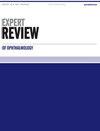Device-based therapies as a boost of conventional treatment in dry eye disease
IF 0.9
Q4 OPHTHALMOLOGY
引用次数: 5
Abstract
ABSTRACT Introduction Dry eye disease (DED) is a multifactorial chronic condition with a broad spectrum of symptoms that can affect daily activities and quality of life. Areas covered New treatment approaches that target more systematically distinct parts of the pathophysiology would present new potential to effectively regulate signs and symptoms of DED. In this review, a comprehensive list of device-based treatments has been provided, according to their mechanism of action. Expert opinion Given the variability and complexity of DED, adjuvant treatments should be considered as a boost for patients who do not respond to first-line therapy. Most of those devices primarily target meibomian glands, using heat or mechanical energy to restore normal meibum flow. Although several treatments have been discussed in this review, further studies are needed to identify new options, evaluate current therapies in randomized clinical trials more extensively, and identify which subtypes of DED could benefit from any given therapy.基于设备的治疗方法对干眼病的常规治疗有促进作用
摘要简介干眼病是一种多因素的慢性疾病,症状广泛,会影响日常活动和生活质量。涵盖的领域针对病理生理学中更系统的不同部分的新治疗方法将为有效调节DED的体征和症状提供新的潜力。在这篇综述中,根据其作用机制,提供了一份基于设备的治疗的综合清单。专家意见鉴于DED的可变性和复杂性,辅助治疗应被视为对一线治疗没有反应的患者的一种促进。这些设备大多主要针对睑板腺,利用热量或机械能恢复正常的睑板流动。尽管本综述中讨论了几种治疗方法,但还需要进一步的研究来确定新的选择,在随机临床试验中更广泛地评估当前的治疗方法,并确定DED的哪些亚型可以从任何给定的治疗中受益。
本文章由计算机程序翻译,如有差异,请以英文原文为准。
求助全文
约1分钟内获得全文
求助全文
来源期刊

Expert Review of Ophthalmology
Health Professions-Optometry
CiteScore
1.40
自引率
0.00%
发文量
39
期刊介绍:
The worldwide problem of visual impairment is set to increase, as we are seeing increased longevity in developed countries. This will produce a crisis in vision care unless concerted action is taken. The substantial value that ophthalmic interventions confer to patients with eye diseases has led to intense research efforts in this area in recent years, with corresponding improvements in treatment, ophthalmic instrumentation and surgical techniques. As a result, the future for ophthalmology holds great promise as further exciting and innovative developments unfold.
 求助内容:
求助内容: 应助结果提醒方式:
应助结果提醒方式:


